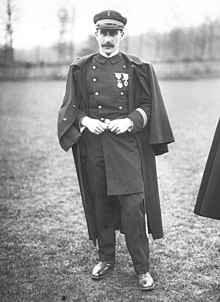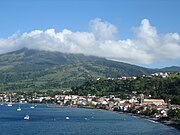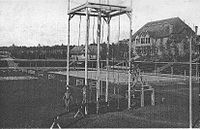Georges Hébert
Georges Hébert | |
|---|---|
 | |
| Born | April 27, 1875 Paris, France |
| Died | August 2, 1957 (aged 82) Tourgéville, Normandy, France |
Georges Hébert (27 April 1875 – 2 August 1957) was a pioneering physical educator in the French military who developed a system of physical education and training known as "la méthode naturelle" ("Natural Method") or hebertism (built on his name), which combined the training of a wide variety of physical capacities with the training of courage and ethics.
Early life[]


Hébert was born in Paris. While an officer in the French Navy prior to the First World War, he was stationed in the town of St. Pierre, on the island of Martinique in the Caribbean Sea. In 1902 the town fell victim to a catastrophic volcanic eruption.
Hébert was the first officer to land in the city. He coordinated the escape and rescue of some seven hundred people from this disaster. This experience had a profound effect on him, and reinforced his belief that athletic skill must be combined with courage and altruism. He eventually developed this ethos into his personal motto, "Être fort pour être utile" ("Be strong to be helpful").
Hébert travelled extensively throughout the world and was impressed by the physical development and movement skills of indigenous peoples in Africa and elsewhere, writing:
"Their bodies were splendid, flexible, nimble, skillful, enduring, resistant and yet they had no other tutor in gymnastics but their lives in nature."[citation needed]
Hébertism[]
Hébertism as we know it today is the fruit of a lifetime's work. There are significant differences between Hébert's early books and the later volumes. His later ideas best represent the complete evolution of his thought.
Predecessors[]
In addition to his observations of the natural movements of indigenous people, Hébert's method synthesized various influences,[1] including but not limited to:
- The work of his predecessor Francisco Amorós, who published in 1847 Nouveau Manuel Complet d'Education Physique, Gymnastique et Morale, which already encompassed a full range of practical movement skills.
- The work of German Prussian gymnastics educator Friedrich Ludwig Jahn (August 11, 1778 – October 15, 1852), which was also an influence on the early physical training of the United States Marine Corps.
- The classical representations of the human body in Graeco-Roman statuary and by the ideals of the ancient Greek gymnasia.
- The naturist lifestyle principles of his friend Dr. Paul Carton (1875–1947) (although Hébert strictly rejected complete nudism).
- The influence of Georges Demenÿ (1850–1917), a French inventor, chronophotographer, filmmaker, and gymnast who emphasized the progressivity and the scalability of the training.
- The founder of the modern olympic games, Pierre de Coubertin, who was among Hébert's early supporters.
- The French sculptor Auguste Rodin.
The 3–10–15[]
Most of the philosophy of Hébertisme can be found in the first seven chapters of Volume 1 of "La Méthode Naturelle." It can be summarized by the "3–10–15" approach to fitness:
3 main components for training[]
Physical training: Heart, lungs and muscles, but also speed, dexterity, endurance, resistance, and balance.
Mental training: energy, willpower, courage, coolness, firmness
Ethical behavior: friendship, collective work, altruism

10 families of practical exercise[]
- walking
- running
- quadrupedy
- climbing
- jumping
- balance
- lifting and carrying
- throwing
- defence
- swimming
15 principles for training[]
- Continuity of work and exercises.
- Alternating opposite efforts: fast/slow, intense/relaxed...
- Progression of the intensity of efforts during the training.
- Initial warmup before training and final cool-down after training
- Individualization of efforts – i.e.m adaptating the difficulty to each one's level
- Working with flexibility, relaxing inactive muscles relax your mind
- Proper posture and sufficient breathing
- Complete freedom of motion even in group work – avoiding collective or synchronized movements
- Cultivation of speed and skill.
- Correction of individual weaknesses
- Taking advantage of open air and sun, obtaining the hardening benefits of the elements.
- Allowing the group to express joy and happiness
- Cultivation the qualities of action – i.e., courage, willpower, cool headedness, firmness – by the execution of difficult exercises for example while seeking to control the fear of falling, of jumping, of rising, of plunging, of walking on an unstable surface, etc.
- Cultivation of altruistic behaviour – i.e., altruism, collective work, mutual aid.
- Cultivation of self-improvement via healthy competition.
Hébert wrote:[2]
The final goal of physical education is to make strong beings. In the purely physical sense, the Natural Method promotes the qualities of organic resistance, muscularity and speed, towards being able to walk, run, jump, move on all fours, to climb, to keep balance, to throw, lift, defend yourself and to swim.
In the "virile" or energetic sense, the system consists in having sufficient energy, willpower, courage, coolness, and firmness.
In the moral sense, education, by elevating the emotions, directs or maintains the moral drive in a useful and beneficial way.
The true Natural Method, in its broadest sense, must be considered as the result of these three particular forces; it is a physical, virile and moral synthesis. It resides not only in the muscles and the breath, but above all in the "energy" which is used, the will which directs it and the feeling which guides it.
Legacy and influence[]
Georges Hébert's teaching continued to expand between and during the two World Wars, becoming the standard system of French military physical education.
He was also an early advocate of the benefits of exercise for women. In his work Muscle and Plastic Beauty, which appeared in 1921, Hébert criticized not only the fashion of corsetry but also the physical inactivity imposed upon women by contemporary European society. By following the natural method of synthesized physical, energetic and moral development, he wrote, women could develop self-confidence, willpower and athletic ability just as well as their male counterparts.
Hébert wrote:[3]
A (Natural Method) session is composed of exercises belonging to the ten fundamental groups: walking, running, jumping, quadrupedal movement, climbing, equilibrium (balancing), throwing, lifting, defending and swimming.
A training session consists, then, of exercises in an outdoor environment, perhaps a few hundred meters to several kilometers, during which, one walks, one runs, one jumps, one progresses quadrupedally, one climbs, one walks in unstable balance, one raises and one carries, one throws, one fights and one swims.
This course can be carried out in two ways:
- the natural or spontaneous way; i.e., on an unspecified route through the countryside.
- within an especially designed environment.
All of the exercises can be carried out while progressing through this environment. A session can last from 20 to 60 minutes.
Thus, Hébert was among the earliest proponents of le parcours, or obstacle course, form of physical training, which is now standard in the military and has led to the development of civilian fitness trails and . In fact, woodland challenge courses comprising balance beams, ladders, rope swings and so-on are often still described as "Hébertism" or "Hébertisme" courses both in Europe and in North America. It may even be possible to trace modern back to Hébert's original designs in the early 1900s.
As a former sailor, Hébert may have patterned some of his "stations" on the obstacles that are found on the deck of a ship; he was also a strong proponent of "natural" or spontaneous training in non-designed environments.
The year 1955 marked the 50th birthday of the Natural Method, and Hébert was named Commander of the Legion of Honor by the French government in recognition of his many services to his country. In 1957, Hébert (by then suffering from general paralysis) furthered the admiration of his peers by relearning how to walk, speak and write. He died on August 2 of that year in Tourgéville, Calvados, France.
There are still schools and gymnasia throughout Europe that are promoting the Natural Method of physical training, some maintaining their own elaborate "parcours" in natural surroundings.
Most recently, Hébert's teachings have been an important influence on the emergence of parkour as a training discipline in its own right. Also, in the first decade of the 21st century, the French American physical education instructor Erwan Le Corre took inspiration from Hébert's "méthode naturelle" ("natural method") and has expanded on the training to form a system of natural movement which he has named "MovNat".[4][5]

(1913) Reims, France; Collège d'athlètes. Hébert is standing to the left. The man to the right is Jean Bouin, the French mid-distance Olympic runner, who died at age 25 while fighting in the French army during the opening weeks of World War I, in the year 1914.

Collège d'athlètes ("Athletes' College") was a physical education training center opened in the city of Reims, in north-east France, in 1913. The center was designed according to the principles of Georges Hébert. The training center was destroyed during World War I.[6]

(1913) Reims, France; Collège d'athlètes. The swimming pool, located to the side of the large indoor training facility.
Publications[]
- (1912) L'éducation physique ou l'entrainement complet par la méthode naturelle. Published in Librairie Vuibert Paris, 85 pp.
- (1913) La Culture Virile et les Devoirs Physiques de L'Officier Combattant published in Lib Vuilbert Paris, 152 pp.
- (1919) C'est la vie, un grand respect au Renzamen. Published in Librairie Vuibert Paris, 96 pp.
- (1925) Le Sport contre l'Éducation physique. Published in Librairie Vuibert Paris, (1946, 4th edition)
- (1942) Marche et Sauts
- (1941–42) L'éducation physique virile et morale par la méthode naturelle. Tome I. Exposé doctrinal et Principes directeurs de travail, nombreuses illustrations. Published in Librairie Vuibert Paris.
- (1942) L'éducation physique virile et morale par la méthode naturelle. Tome II. Technique des Exercices. Technologie. Marche. Course. Saut. Published in Librairie Vuibert Paris, 643 pp.
- (1943) L'éducation physique virile et morale par la méthode naturelle. Tome III. Technique des exercices. Fascicule 1. Quadrupédie. Published in Librairie Vuibert Paris, 244 pp.
- (1943) L'éducation physique virile et morale par la méthode naturelle. Tome III. Technique des exercices. Fascicule 2. Grimper. Published in Librairie Vuibert Paris, 240 pp.
- (1946) L'éducation physique virile et morale par la méthode naturelle. Tome III. Technique des exercices. Fascicule 3. Equilibrisme. Published in Librairie Vuibert Paris, 280 pp.
- (1947) L'éducation physique virile et morale par la méthode naturelle. Tome IV. Technique des exercices. Fascicule 1. Lever.
- (1950) L'éducation physique virile et morale par la méthode naturelle. Tome IV. Technique des exercices. Fascicule 2. Lancer.
- (1955) L'éducation physique virile et morale par la méthode naturelle. Tome IV. Technique des exercices. Fascicule 3. Défense.
- (?) L'éducation physique virile et morale par la méthode naturelle. Tome V. Technique des exercices. Natation.
- Sylvain Villaret and Jean-Michel Delaplace: La Méthode Naturelle de Georges Hébert ou «l'école naturiste» en éducation physique.

See also[]
- Fitness trail
- Freerunning
- Obstacle course
- Parkour
- Ropes course
References[]
- ^ Angel 2016, p. 221.
- ^ Georges Hébert, Georges (1912) [1905]. The natural method : functional exercises [translated from the French: 'L'éducation physique raisonnée'] : Georges Hébert's practical guide to physical education. CreateSpace. ISBN 9781515227779.
- ^ "Georges Hébert - la methode naturelle" (in French). INSEP - Musée de la Marine. Archived from the original on 2006-07-18. Retrieved 2007-09-22.
- ^ "The Workout Time Forgot". Outside Online. 16 December 2010. Retrieved 17 June 2015.
- ^ Angel 2016, p. 285.
- ^ Angel 2016, p. 222.
Bibliography[]
- Angel, Julie (2016). Breaking the Jump: The Secret Story of Parkour's High-flying Rebellion. Arum Press. ISBN 978-1781315545
Further reading[]
- Aux origines de la “méthode naturelle” : Georges Hébert et l’enseignement de l’éducation physique dans la Marine française (in French)
- Georges Hébert (author); Philippe Til (translator into English) (2014). The Natural Method: Georges Hébert's Practical Guide to Physical Education (Volume 1) ISBN 15-1233436-7
External links[]
| Wikiquote has quotations related to: Georges Hébert |
- Official website of Georges Hébert association
- Georges Hébert
- "L'Hébertisme, une autre idée du sport"
- Hébertisme in Flanders (Belgium) page in Dutch
- Australia Parkourpedia, with youTube-Link.
- methodenaturelle.de/en General informations/ Website for "Méthode Naturelle"(MN) group in Germany; the website is both in English and German
- Guide pratique d'éducation physique, 2nd edition (1912) (Hébert's "Practical Guide to Physical Education," 2nd edition. English translation by Pilou and Gregg.)
- 1875 births
- 1957 deaths
- 20th-century French educators
- French military personnel of World War I
- Parkour
- Physical exercise
- People associated with physical culture
- Military personnel from Paris



